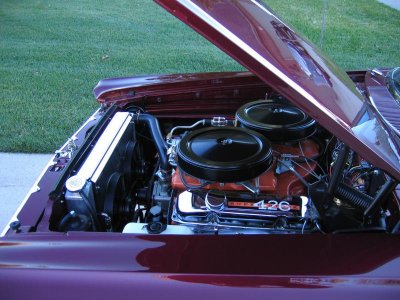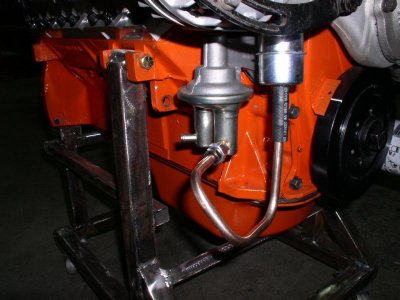Any thoughts on installing the fuel filter before the pump? I'm getting set to route the fuel line on my new 451. I installed a new 3/8" sending unit as well as a 3/8" front to rear line. I picked up the same pump I used on my Charger. This is the one with a 5/16" female thread as the output and a 3/8 tube for the inlet. On the Charger a short 5/16 hard line goes between the pump and fuel separator, but I am not running a return line on this car. Thinking of using a 5/16 to 3/8 reducer fitting and bending up a 3/8" line from pump to the Holley carb. Then the only hose I need is between the main line and the pump, which is where I would put the filter. Is this a bad idea? Just thought it would eliminate a couple of hose connections and also get the filter out from behind the alternator.
You are using an out of date browser. It may not display this or other websites correctly.
You should upgrade or use an alternative browser.
You should upgrade or use an alternative browser.
Fuel filter location ???
- Thread starter hunt2elk
- Start date
lewtot184
Well-Known Member
never put a fuel filter on the suction side of a mechanical pump. a 100 micron filter can be put on the suction side of an electric pump, but i don't have a warm fuzzy about any restriction on the suction side of any pump.
Everything I've heard is to let the gas push thru the filter. Not to pull it thru it.
lewtot184
Well-Known Member
cellulose filters were never designed to be used on the suction side of a pump or used in a vacuum. a mech pump will pull anywhere from 15"-19" of vacuum, less than half an atmosphere. the fuel will vaporize before it goes thru the pump and the filter may come apart.
747mopar
Well-Known Member
I asked the same thing, I was told the strainer on the sending unit will get anything big enough to effect the pump out and to just put a filter on the carb feed line which is the way I've been running it. I came out of my pump with a 3/8" AN fitting then used braided line up to a Summit inline billet filter (also AN fittings) and back out with the same braided line to the carb. I can take a pic but it works out nice with a bracket holding it out clear of the headers.
Propwash
Well-Known Member
- Local time
- 4:32 PM
- Joined
- Oct 29, 2009
- Messages
- 9,711
- Reaction score
- 4,312
- Location
- Island of Misfit Toys
There's plenty of in-line filters you can buy that are not paper/cellulose, but fine screen/mesh down to 20 Micron, and will easily out-flow GPH capabilities of your mechanical fuel pump. You'd could install those before the pump, but like Dev mentioned, your sender screen/mesh should weed out anything big enough to damage the diaphragm in the pump. I wouldn't install a cellulose filter before the pump either, so adding a filter before and after the pump seem's pretty redundant. That is unless you're running some real serious power & moola under the hood. Guess it would be a cheap enough insurance policy for $20-30 bucks, but sure seem's like it would be over doing it....
I wouldn't install a cellulose filter before the pump either, so adding a filter before and after the pump seem's pretty redundant. That is unless you're running some real serious power & moola under the hood. Guess it would be a cheap enough insurance policy for $20-30 bucks, but sure seem's like it would be over doing it....
I am just using 1 standard filter, not trying to use 2. I'll put it between the pump and carb and call it a day.
Propwash
Well-Known Member
- Local time
- 4:32 PM
- Joined
- Oct 29, 2009
- Messages
- 9,711
- Reaction score
- 4,312
- Location
- Island of Misfit Toys
Sounds like a good plant to me Joel. I do the same thing as well.
Happy Plumbing!
Happy Plumbing!
Dako
Well-Known Member
The factory location for the fuel filter on my '72 Dodge pickup was prior to the mechanical pump. Never had an issue.
66chargerpat
Well-Known Member
If your Holley is a dual feed, you can use the filters that go in the bowl fittings. They look like brass, but they filter just fine. It look a lot cleaner too.
Already pulled those out, and will just run the on cannister style inline.If your Holley is a dual feed, you can use the filters that go in the bowl fittings. They look like brass, but they filter just fine. It look a lot cleaner too.
lewtot184
Well-Known Member
those small moraine sintered bronze filters in the float bowls aren't a bad idea. they're not restrictive, 40 micron at best, and being spring loaded they'll bypass fuel if clogged up. i use them.
those small moraine sintered bronze filters in the float bowls aren't a bad idea. they're not restrictive, 40 micron at best, and being spring loaded they'll bypass fuel if clogged up. i use them.
Well there is one fact about this hobby - everybody seems to have totally different opinions on pretty much everything. The only reason I removed them on this carb is that my engine builders Dad (who does the dyno tuning) says he always removes them, and has for 40 years. Then I was talking to a buddy of mine a couple days later and he said he always removes them also. He said he has heard of them plugging up, leaning out the motor, and causing damage. Now I really don't know what to think of them. I still have them installed in my Charger, but was going to take them out. Maybe I will leave them be. :thinker:
Propwash
Well-Known Member
- Local time
- 4:32 PM
- Joined
- Oct 29, 2009
- Messages
- 9,711
- Reaction score
- 4,312
- Location
- Island of Misfit Toys
Well there is one fact about this hobby - everybody seems to have totally different opinions on pretty much everything
Hehehehehe.......No doubt huh Joel. Ask one question, get 5 answers. It's all about reading between the lines amigo.
lewtot184
Well-Known Member
it's unfortunate that this type of advice is handed down decade after decade. i would challenge them if they've had first hand experience with "plugging and leaning". those filters have a spring that lets fuel bypass even if plugged and if the fuel system is that dirty an inline cellulose filter would "clog and lean" much quicker. just old '60's nonsense!Well there is one fact about this hobby - everybody seems to have totally different opinions on pretty much everything. The only reason I removed them on this carb is that my engine builders Dad (who does the dyno tuning) says he always removes them, and has for 40 years. Then I was talking to a buddy of mine a couple days later and he said he always removes them also. He said he has heard of them plugging up, leaning out the motor, and causing damage. Now I really don't know what to think of them. I still have them installed in my Charger, but was going to take them out. Maybe I will leave them be. :thinker:
ilm65
Well-Known Member
 Aside from the filter issue, my thinking is if you encounter a 5/16" opening anywhere in the routing of your 3/8" line, you've defeated the purpose of going to 3/8" since you've just introduced a restrictor. I'm running two 600 cfm Edelbrocks on my 440 max wedge (A&A manifold) and went with an Edelbrock #EDE1723 mechanical pump with 3/8" inlet and 3/8" outlet; absolutely no fuel starvation at WOT.
Aside from the filter issue, my thinking is if you encounter a 5/16" opening anywhere in the routing of your 3/8" line, you've defeated the purpose of going to 3/8" since you've just introduced a restrictor. I'm running two 600 cfm Edelbrocks on my 440 max wedge (A&A manifold) and went with an Edelbrock #EDE1723 mechanical pump with 3/8" inlet and 3/8" outlet; absolutely no fuel starvation at WOT.
Last edited:
Aside from the filter issue, my thinking is if you encounter a 5/16" opening anywhere in the routing of your 3/8" line, you've defeated the purpose of going to 3/8" since you've just introduced a restrictor. I'm running two 600 cfm Edelbrocks on my 440 max wedge (A&A manifold) and went with a Carter 100 gph mechanical pump with 3/8 inlet and 3/8 outlet; absolutely no fuel starvation at WOT.[/B]
Well, here is what I am thinking about doing. The pump has a 3/8" inlet barb, and a threaded fitting on the output which accepts a 5/16" threaded hard line. I would run 3/8" tubing up to the carb through a 3/8" filter. The restriction would be the 5/16" output of the pump and the 5/16 to 3/8 adapter. I don't know if it applies to this, but when I install 2 pound pressure lp or natural gas lines in houses, it is quite common for the outputs of the regulators to be a smaller size than the low pressure output line. It seems like it is not so much of a problem if the bottleneck is right at the output of the reg? What is the # for the pump you are using? Will it fit a 400 block?

lewtot184
Well-Known Member
i would be very concerned about the capabilities of that pump.Well, here is what I am thinking about doing. The pump has a 3/8" inlet barb, and a threaded fitting on the output which accepts a 5/16" threaded hard line. I would run 3/8" tubing up to the carb through a 3/8" filter. The restriction would be the 5/16" output of the pump and the 5/16 to 3/8 adapter. I don't know if it applies to this, but when I install 2 pound pressure lp or natural gas lines in houses, it is quite common for the outputs of the regulators to be a smaller size than the low pressure output line. It seems like it is not so much of a problem if the bottleneck is right at the output of the reg? What is the # for the pump you are using? Will it fit a 400 block?
View attachment 235986
What would you suggest? Something like this? http://www.summitracing.com/parts/crt-m4862/overview/make/dodge What kind of power is a stock pump good for?
Similar threads
- Replies
- 18
- Views
- 847
















